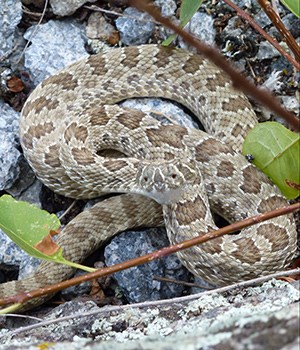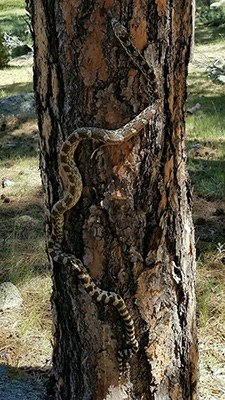
NPS photo Aside from a few exceptions, most of the reptiles seen at Devils Tower National Monument are snakes. Only one venomous species is present: the prairie rattlesnake. The most commonly seen reptile is the bullsnake (or gopher snake). These frequent the area around the Tower Trail, especially in early summer. As with most wild animals, reptiles do not pose a threat to humans. However, any wild animal can be dangerous, and should be treated with respect. Snakes
Other Reptiles

NPS photo Poisonous or Venomous?It may surprise you to hear that there are no poisonous snakes. A poison is a substance that is touched, inhaled or ingested. There are many venomous snake species; a venom is injected.The only venomous snake found at the park is the prairie rattlesnake. Venomous snakes possess this special adaptation not for defense, but for killing their prey. As such, venomous snakes are uninterested in humans. They are ambush predators, waiting for a prey animal, such as a small rodent, to cross their path to strike and envenomate. This kills the prey so the snake can eat at its leisure. Rattlesnakes are members of the pit viper family. This name derives from the pits between their eyes and nostrils. These pits house special organs which allow the snake to sense via infrared, aiding it to find prey. If you do see a rattlesnake, it is likely coiled waiting for prey (not you) to cross its path. Unlike their venom, the rattle of a rattlesnake is for defence. It is the snake's way of saying "I am here, I am scared, and I could be dangerous - so leave me alone!" This is such an effective defence that other snakes will mimic the rattle by shaking their tail in dry brush or hissing. Sometimes the prairie rattlesnake will not give this alarm call, but rely on its camouflage to remain hidden. 
NPS photo A Common SightBullsnakes - also known as gopher snakes - are the most commonly seen reptile in the park. They are also the largest snake species found at the Tower. Bullsnakes can be up to seven feet in length, and longer specimens have been recorded. They frequent the ponderosa pine forest and rocky slopes at the base of the Tower.Bullsnakes can be identified by their yellow body color. They have dark brown to black splotches across their body, which turn into rings as they get closer to the tail. They have a rounded head, unlike the wedged-shaped head common to many venomous snakes. Like many snakes, bullsnakes are excellent climbers. They are one of the reptile species sometimes found on the Tower itself. Although bullsnakes can mimic rattlesnakes - flattening their head, coiling their body and hissing - they are not venomous. In fact, bullsnakes rarely tolerate rattlesnakes in their territory. They have been known to predate upon rattlesnakes. So if you do not want any rattlesnakes (or rodents) around, it might be wise to keep a bullsnake around! 
NPS photo / Michael Wheeler |
Last updated: April 24, 2025
